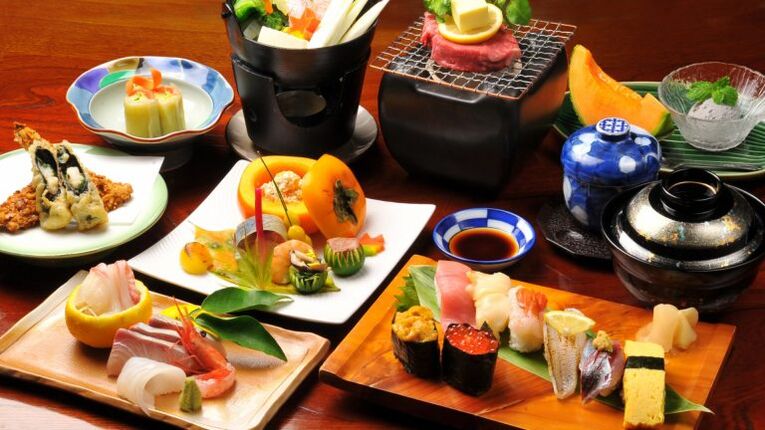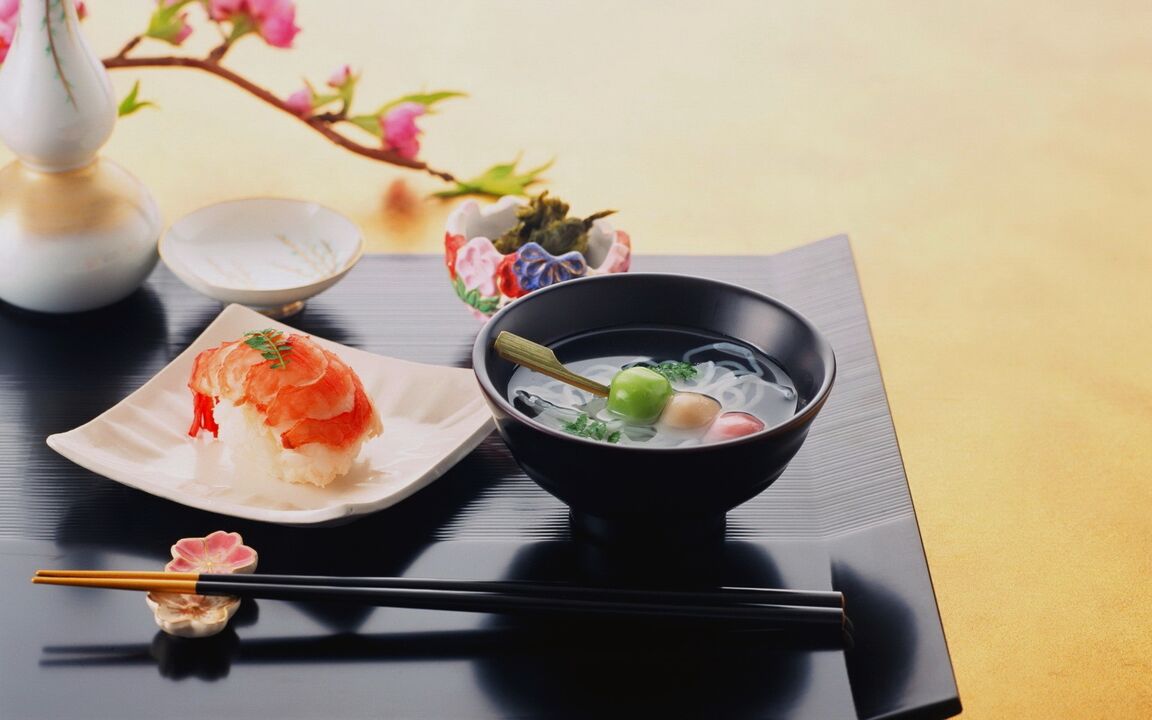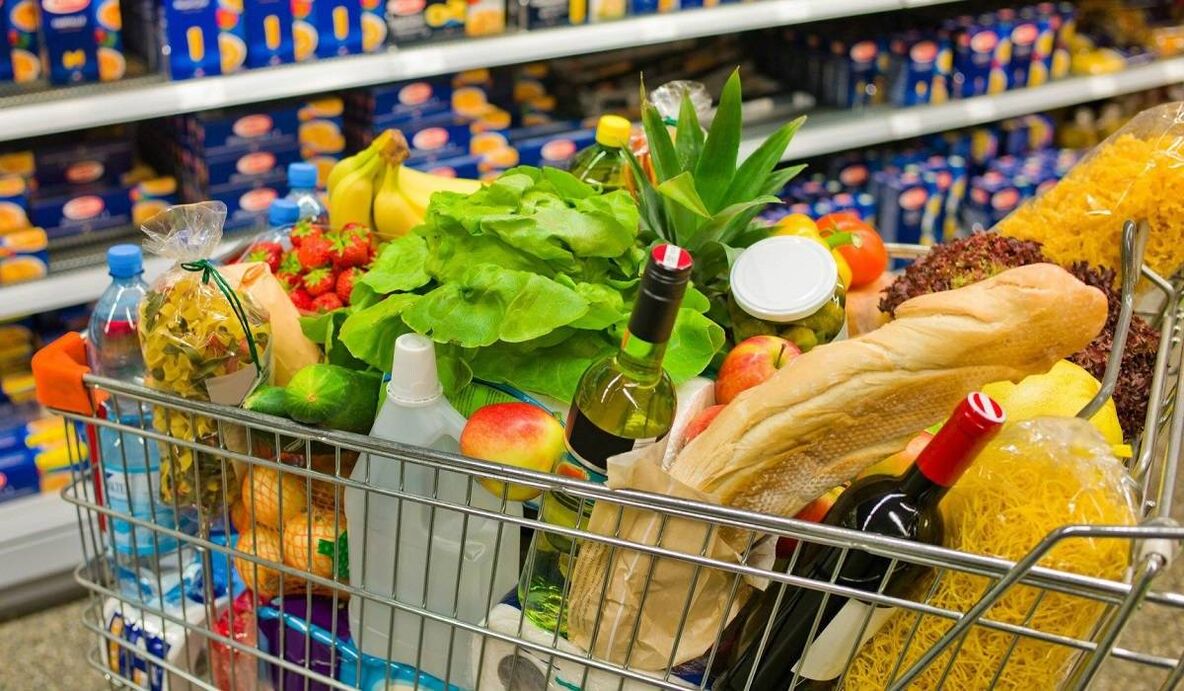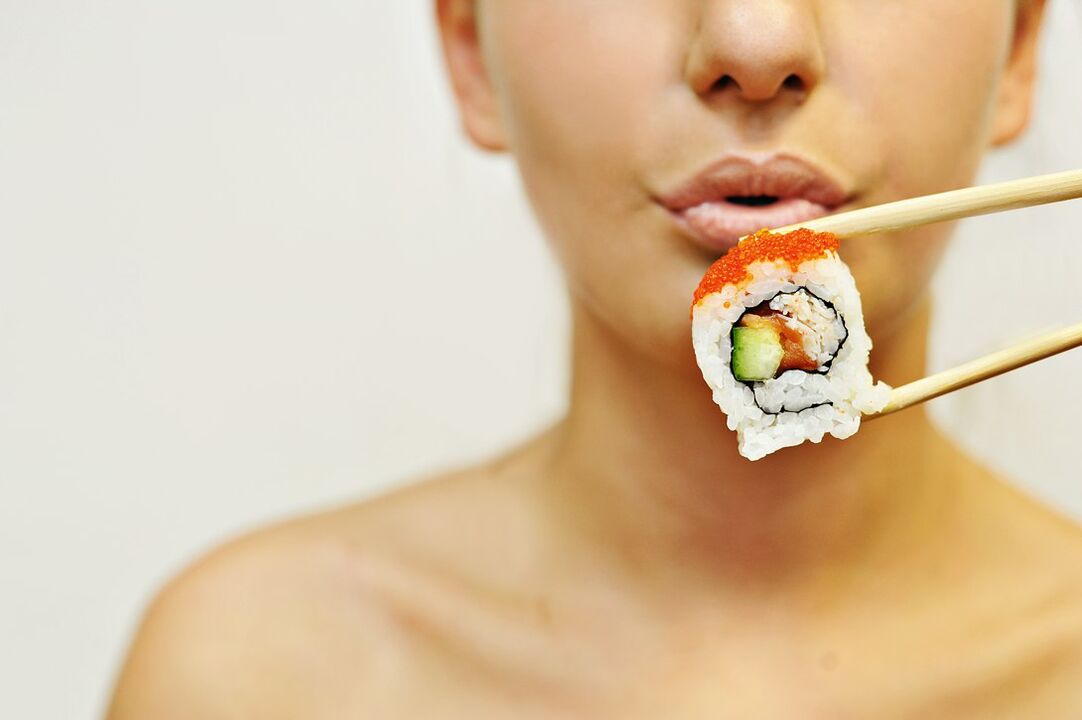In recent years, the Japanese diet has become so popular that it combines both quick effects and benefits for the body. Moreover, the main feature of this 2-week eating plan is that it does not have a so-called rollback, when everything is back to the way it was after 2-3 weeks.
Japanese food is becoming more and more popular thanks to the popularity of Japanese cuisine at cafes and restaurants in the country. In most cooking jobs these days, you can buy spring rolls or whatever you need to make your own. So what is the Japanese weight loss diet?

Main features of the Japanese diet for 14 days
Let's take a quick look at what the Japanese weight loss diet is and what principles are it based on:
- Total time is 14 days;
- Food low in carbohydrates, low in carbohydrates, high in protein. Requires discipline and endurance;
- Total cost - no more than 2, 000 rubles for the entire cycle;
- Estimated results are between 5 and 8 kg;
- Possibility of repetition - no more than twice a year;
- Stability - high, with the correct exit from the diet after two weeks, the results will last for a long time and there is no rebound;
- Contraindications: pregnancy, lactation, diseases of the gastrointestinal tract (ulcers, gastritis, gastritis, etc. ), kidney and liver diseases. It is also not recommended when there are heart problems. Before starting a diet, it is advisable to consult
The Japanese weight loss diet - is it hyped or really effective?

The old Japanese diet was completely foreign. Furthermore, the concept of "dieting" implies severe reductions in food and calories, up to and including hunger. Even when this unconventional eating plan became popular, many people still believed that the 14-day Japanese diet would consist of sushi, green tea, and of course rice. However, you should not judge this diet by just traditional Japanese cuisine, all that will make you remember it in two weeks is sea fish, eggs and green tea - products already available. present in many countries around the world. This is a great advantage of the diet, because in the diet there will be familiar foods, without any strange things, which can lead to digestive disorders, even allergies.
It is not yet known exactly how the Japanese 14-day diet relates to the country of the Rising Sun. According to some reports, it was developed in one of the Japanese clinics, according to others, this nutritional plan is made in Japan because of its strict discipline, menu and effectiveness. However, where this diet comes from is not so important given the fact that it is extremely effective and harmless, when handled and followed properly.
As with any other way, the Japanese menu implies cutting calories in the diet. It is based on traditional Japanese cuisine, which is famous for being free of fatty foods and rich in vegetables and fish. One of the famous public figures and nutritionist Naomi Moriyama believes that nutrition is the secret to maintaining the beauty and slim figure of Japanese women into old age. The key, she says, is low carbs and small servings.
According to Naomi's calculations, the Japanese consume 25% fewer calories than people in any other country. For example, with various snacks and even so-called fast food, chips, chocolate bars, fatty candies and even butter are not particularly popular in Japan. Even "street food" is low in calories, fat and carbohydrates. So, the menu of the Japanese diet is completely in line with the food culture, traditions and background of the diet in the country.
The correct diet to burn fat is a must! But think about the end result you want to get? Are you sure that after removing excess fat, you will see a toned and healthy body? To tone muscles and gain sex mass, you need to train the right way! And to make it easier for you, we provide a pre-made training plan diagram!
Concepts and main rules of the Japanese diet

The size of the population composition of the CIS and Japan is significantly different, so for many, a dramatic transition can be a real test. But do not be sad, because this plan is designed for two weeks, after which it is possible to slowly return to your usual diet and favorite foods.
Protein should be the foundation of your diet and a source of satiety. You can only get it from the following products:
- A fish;
- Egg;
- Chicken breast;
- Dairy products;
- Lean beef.
Only crackers and some vegetables are carbohydrates. As for the fat - olive oil. In addition, fat will be contained in fish and other protein products, which will avoid a deficiency. The menu and planning of the 14-day Japanese diet with significant restriction of calories, especially carbohydrates, can be a real challenge. However, it should be borne in mind that the body will quickly get used to such a diet, and the second week will not be so difficult.
It is important to note that healthy fiber is available in sufficient quantities in the menu. It is found in vegetables, which can be consumed virtually without restriction (on certain days only). This eliminates any gastrointestinal problems and improves digestion. Green tea and coffee are also included in the diet. They not only help you stay awake, avoid fatigue, but also provide the body with a large amount of antioxidants. The important thing is that the tea is natural, free of dyes and flavorings, so buy whole beans and grind your own.
Looking through the 14-day menu of the Japanese diet, you can be sure that all the beneficial substances are present in this diet and that the main changes mainly affect the portion size andamount of food consumed. Basically, two weeks for most people go by without consequences, but if your body reacts too harshly to cutting carbohydrates, it's a good idea to postpone future diets. and see a doctor. The main symptoms of this would be headaches, severe weakness and fatigue.
Diet is of great importance. You need to drink plenty of filtered water at room temperature. First, it will help improve digestion and cope with hunger more easily by simulating a full stomach. Second, it will allow you to eliminate protein processed products from the body. Another important point is to strictly follow the general plan. If you really decide to try and check out how to lose weight following the Japanese diet, then you should only consume those foods in the amounts provided for each day. No substitution allowed. You also cannot change or rearrange the dates.
The only exceptions are coffee and tea. In the morning, instead of coffee, you can drink a cup of tea, depending on personal preference. There is no way, of course. Salt is also a negative factor in the diet, but if you can't completely cut it out, keep it to a minimum.
One of the main difficulties, in addition to the low calorie content, is also considered the small number of meals a day. While other diets include 5 or even 8 snacks per day, the Japanese diet consists of only 3 main meals. Also remember that you need to start your day with a glass of water, this will "warm up" your body and metabolism. Dinner should not be eaten earlier than 2-3 hours, so that when sleeping, the food has time to digest.
This is a strict diet, so it's a good idea to follow a smooth diet that doesn't include cutting transitions in the diet. This way the body will quickly adapt to the new conditions and the diet will be more comfortable. The easiest way to prepare is to completely stop fast food at least 3-5 days before starting the diet, as well as cut down on portions (eat no more than half of the usual serving). Although this plan may seem too rigid, it is completely balanced and does not harm the body, and allows you to lose 5-8 kg in just 2 weeks.
Grocery prep and shopping phase

You will need:
- Coffee (ground or cereal) - 1 pack;
- Natural green tea - 1 pack;
- Chicken eggs - 20 pieces;
- Lean beef (leaf) - 1 kg;
- Sea fish (fillets) - 2 kg;
- Chicken fillet - 1 kg;
- Extra virgin olive oil - 0. 5 l;
- Carrots - 2-3 kg;
- White cabbage - 2 medium pieces;
- Eggplant or zucchini - 1 kg;
- Fruits (anything other than grapes and bananas) - 1 kg;
- Kefir - 1 l;
- Tomato juice - 1 l;
- Lemon - 2 fruit.
In terms of principles and food lists, the Japanese diet is often compared and even confused with the "chemical diet" - a nutritional plan developed in the United States. Its creator is Osama Hamdiy, whose diet is actively used in the treatment of diabetes and obesity. The Japanese diet also applies the principle of limiting carbohydrates and increasing protein intake, so the chemical reaction of metabolism in the body changes, triggering a chain reaction that leads to strong weight loss. However, there is one important difference between these meal plans. The Osama Hamdiya system includes an unlimited number of products, allowing you to count on muscle building and strong training. At the same time, the Japanese program has a strict limit in number and is as short as two weeks. This is a plus for those who want quick results and can't exhaust their bodies for months, avoiding the usual fad diets.
Detailed menu of the daily Japanese diet

It is important to take this scheme very seriously, strictly implementing the recommendations. Any attempt to circumvent the schema or add products can lead to an overall worse-than-expected result. The daily menu of the Japanese diet for 14 days is as follows:
Day 1
- Breakfast - pure coffee without milk or sugar;
- Lunch - boiled eggs (2 pcs), boiled cabbage with olive oil, 1 glass of tomato juice;
- Dinner - 200 g of fried or boiled fish.
2nd day
- Breakfast - Coffee and 1 slice of rye bread;
- Lunch - 200 g of fried or boiled fish with boiled cabbage and olive oil;
- Dinner - 100 g of boiled beef and 1 glass of kefir.
3rd day
- Breakfast - a slice of rye bread (dried in a toaster) or a biscuit without additives. A cup of coffee;
- Lunch - fry eggplant or zucchini in olive oil (any serving);
- Dinner - boiled 200g of unsalted beef, fresh cabbage with olive oil, 2 boiled eggs.
4th day
- Breakfast - a small fresh carrot with lemon juice;
- Lunch - 200 g of fried or boiled fish, 1 glass of tomato juice;
- Dinner - 200 g of fruit (any).
Day 5
- Breakfast - a medium carrot with lemon juice;
- Lunch - boiled or steamed fish with a glass of tomato juice;
- Dinner - 200 grams of fruit (any).
6th day
- Breakfast - a cup of coffee without sugar;
- Lunch - boiled chicken without salt (500 g), fresh carrot and cabbage salad (seasoned with olive oil);
- Dinner - a fresh carrot and 2 boiled eggs.
7th day
- Breakfast - a cup of green tea;
- Lunch - boiled beef without salt (200g);
- Dinner - your choice: 200g fruit, 200g boiled beef with a glass of kefir, 200g boiled fish or 2 boiled eggs with salad (carrots mixed with olive oil.
8th day
- Breakfast - a cup of coffee;
- Lunch - 500 g of boiled chicken without salt, cabbage and carrot salad (seasoned with olive oil);
- Dinner - a small carrot with olive oil, 2 boiled eggs.
9th day
- Breakfast - a carrot with lemon juice;
- Lunch - 200 g of fried or boiled fish and a glass of tomato juice;
- Dinner - 200 g of optional fruit.
Day 10
- Breakfast - a cup of coffee;
- Lunch - 3 small carrots (fried in vegetable oil), 1 egg and 50g of cheese;
- Dinner - 200 g of any fruit.
11th
- Breakfast - a cup of coffee and 1 slice of rye bread;
- Lunch - fry eggplant or zucchini in olive oil (any amount);
- Dinner - 200 g of boiled beef, fresh cabbage with olive oil, 2 boiled eggs.
12th day
- Breakfast - a cup of coffee and a slice of rye bread;
- Lunch - 200 g of fried or boiled fish, fresh cabbage with olive oil;
- Dinner - 100 g of boiled beef and 1 glass of kefir.
13th day
- Breakfast - a cup of coffee;
- Lunch - 2 boiled eggs, boiled cabbage with olive oil and 1 glass of tomato juice;
- Dinner - fry 200g of fish in olive oil.
14th day
- Breakfast - a cup of coffee;
- Lunch - fried or boiled fish, fresh cabbage with olive oil;
- Dinner - 200 grams of boiled beef, 1 glass of kefir.
It is suggested that this diet allows you to get the most stable and long-term results, without returning to normal weight. After losing weight, you can maintain the weight for up to 3 years, but only if you strictly follow the diet and do not start to compensate everything with high-calorie foods immediately after the 15th day. Alternatively, a great solution would be to tailor a Japanese meal to your daily diet.












































